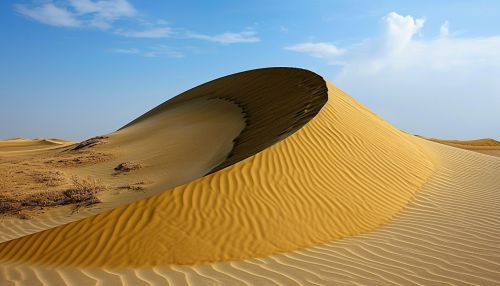Dune migration
Introduction
Dune migration refers to the movement of sand dunes due to the action of wind, water, or other natural forces. This is a complex process that involves the interaction of various physical and environmental factors. Dune migration plays a significant role in shaping the landscape of desert and coastal regions, and has important implications for ecosystem dynamics and human activities.
Formation of Sand Dunes
Sand dunes are formed by the accumulation of sand particles that are transported by wind or water. The formation process begins when an obstacle, such as a rock or vegetation, interrupts the flow of wind or water, causing the sand particles to deposit. Over time, these deposits grow in size and take on characteristic shapes, forming dunes.
The formation of sand dunes is influenced by several factors, including the availability of sand, the velocity and direction of the wind or water, and the presence of obstacles. The type of dune formed depends on these factors, with different types of dunes exhibiting distinct shapes and patterns of movement.
Types of Sand Dunes and Their Migration Patterns
There are several types of sand dunes, each with its own unique shape and pattern of migration. These include:
Barchan Dunes


Barchan dunes are crescent-shaped dunes that form in areas with limited sand supply and a unidirectional wind. The horns or tips of the dune point downwind, and the dune moves in the direction of the wind. Barchan dunes can migrate at a rate of up to 25 meters per year, depending on wind speed and sand availability.
Transverse Dunes
Transverse dunes are a series of long, straight dunes that form perpendicular to the wind direction. They typically occur in areas with a large supply of sand and a constant wind direction. Transverse dunes migrate downwind as the wind blows sand up the gentle windward slope and deposits it on the steep leeward slope.
Parabolic Dunes
Parabolic dunes, also known as U-shaped or blowout dunes, are formed by strong winds that blow out the center of the dune, leaving a U-shaped depression. The arms of the U point upwind, opposite to the direction of dune migration. Parabolic dunes are common in coastal areas and vegetated sand fields, where vegetation stabilizes the arms of the dune while the center migrates downwind.
Longitudinal Dunes
Longitudinal dunes, also known as seif dunes, are long, narrow dunes that form parallel to the wind direction. They are common in areas with bidirectional winds and a moderate supply of sand. Longitudinal dunes can migrate in the direction of the dominant wind, but their movement is often slower and more complex than that of other dune types.
Factors Influencing Dune Migration
Dune migration is influenced by a variety of factors, including wind speed and direction, sand supply, vegetation cover, and human activities. Changes in any of these factors can alter the rate and direction of dune migration.
Wind Speed and Direction
Wind is the primary force driving dune migration. The speed and direction of the wind determine how much sand is transported and in what direction. Changes in wind patterns can cause dunes to migrate in different directions or at different rates.
Sand Supply
The availability of sand is a crucial factor in dune migration. A large sand supply allows for the formation and migration of large dunes, while a limited sand supply can restrict dune formation and movement.
Vegetation Cover
Vegetation can stabilize sand dunes and slow down or prevent their migration. Plants trap sand particles and prevent them from being blown away by the wind. In areas with dense vegetation, dunes may become stabilized and cease to migrate.
Human Activities
Human activities can significantly impact dune migration. Construction, mining, and other activities can alter the landscape and disrupt natural dune formation and migration processes. In some cases, human activities may accelerate dune migration, while in others, they may slow it down or stop it altogether.
Impacts of Dune Migration
Dune migration can have significant impacts on ecosystems and human activities. It can alter habitats, bury infrastructure, and create or destroy landforms.
Ecological Impacts
Dune migration can affect local ecosystems by altering habitats and disrupting ecological processes. As dunes migrate, they can bury vegetation and other features of the landscape, leading to changes in species composition and ecosystem dynamics.
Impacts on Human Activities
Dune migration can also impact human activities, particularly in desert and coastal regions. Migrating dunes can bury roads, buildings, and other infrastructure, posing challenges for land use planning and management.
Management of Dune Migration
Managing dune migration is a complex task that requires a balance between protecting natural processes and mitigating negative impacts on human activities. Strategies for managing dune migration include stabilizing dunes with vegetation or physical structures, altering land use practices, and planning infrastructure to accommodate dune movement.
